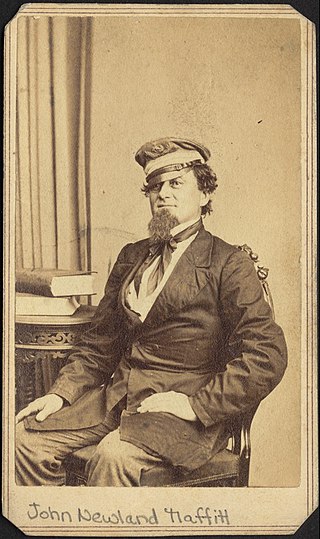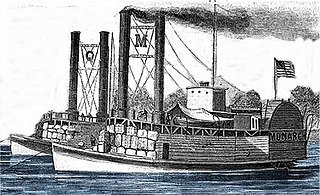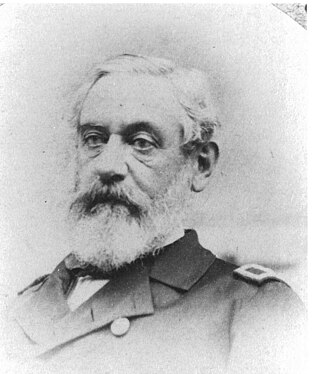
Charles William Read, known commonly as "Savez", was an officer in the antebellum United States Navy and then in the Confederate Navy during the American Civil War. He was nicknamed the "Seawolf of the Confederacy" for his exploits and daring.

USS Essex was a 1000-ton ironclad river gunboat of the United States Army and later United States Navy during the American Civil War. It was named by her captain, William Porter, for his father's old sailing frigate, the USS Essex. This Essex was originally constructed in 1856 at New Albany, Indiana as a steam-powered ferry named New Era.

Franklin Buchanan was an officer in the United States Navy who became the only full admiral in the Confederate Navy during the American Civil War. He also commanded the ironclad CSS Virginia.

CSS Tennessee was a casemate ironclad ram built for the Confederate Navy during the American Civil War. She served as the flagship of Admiral Franklin Buchanan, commander of the Mobile Squadron, after her commissioning. She was captured in 1864 by the Union Navy during the Battle of Mobile Bay and then participated in the Union's subsequent Siege of Fort Morgan. Tennessee was decommissioned after the war and sold in 1867 for scrap.

John Randolph Tucker, an American naval officer who served in the navies of three nations. He was a commander in the United States Navy, captain in the Confederate States Navy, and rear admiral in the Peruvian Navy. As president of the Peruvian Hydrographic Commission of the Amazon, he contributed to the exploration and mapping of the upper Amazon Basin.

John Newland Maffitt was an officer in the Confederate States Navy who was nicknamed the "Prince of Privateers" due to his success as a blockade runner and commerce raider in the U.S. Civil War.

The USS Queen of the West was a sidewheel steamer ram ship and the flagship of the United States Ram Fleet and the Mississippi Marine Brigade. It was built at Cincinnati, Ohio in 1854. It served as a commercial steamer until purchased by Colonel Charles Ellet Jr. in 1862 and converted for use as a ram ship. The ship operated in conjunction with the Mississippi River Squadron during the Union brown-water navy battle against the Confederate River Defense Fleet for control of the Mississippi River and its tributaries during the American Civil War.

Charles Rivers Ellet was a colonel in the Union Army during the American Civil War. He served in the United States Ram Fleet under his father Charles Ellet, Jr. and as commanding officer of the ram fleet as part of the Mississippi Marine Brigade under his uncle Alfred W. Ellet. He commanded the ram ships USS Queen of the West, USS Switzerland, USS Lancaster and USS Monarch during the brown-water navy battle for control of the Mississippi River and its tributaries as part of the Vicksburg Campaign from 1862 to 1863.

The United States Ram Fleet was a Union Army unit of steam powered ram ships during the American Civil War. The unit was independent of the Union Army and Navy and reported directly to the Secretary of War, Edwin M. Stanton. The ram fleet operated in coordination with the Mississippi River Squadron during the Union brown-water navy battle against the Confederate River Defense Fleet for control of the Mississippi River and its tributaries.

USS Monarch was a United States Army sidewheel ram that saw service in the American Civil War as part of the United States Ram Fleet and the Mississippi Marine Brigade. She operated on the Mississippi River and Yazoo River during 1862 and 1863.

The Mississippi Marine Brigade was a Union Army amphibious unit which included the United States Ram Fleet and operated from November 1862 to August 1864 during the American Civil War. The brigade was established to act swiftly against Confederate forces operating near the Mississippi River and its tributaries. The brigade was commanded by Brigadier General Alfred W. Ellet and operated in coordination with the Mississippi River Squadron during the Union brown-water navy battle against the Confederate River Defense Fleet and land based forces. The brigade was independent of the Union Army and Navy and reported directly to the Secretary of War, Edwin M. Stanton. Despite the name, it was never part of the United States Marine Corps.
George Washington Gift (1833–1879), U.S. Navy officer, writer, banker, civil engineer, politician, Confederate Navy officer, businessman, and newspaper editor.

CSS Tuscaloosa was an ironclad warship that served in the Confederate States Navy during the American Civil War. Construction began in May 1862, under a contract with Henry D. Bassett. Her engines were taken from the steamboat Chewala, and she was armored with 4 inches (10 cm) of iron and armed with four cannons. In January 1863, she was launched, and traveled down to Mobile, Alabama for service on Mobile Bay. Both Tuscaloosa and her sister ship CSS Huntsville were found to be too slow for practical use, and were relegated to service as floating batteries. Union forces captured Mobile in April 1865, and Tuscaloosa was scuttled on April 12, as she was unable to escape due to an inability to steam against the current on the Spanish River. Her wreck was discovered in the 1980s.

William Edgar Le Roy was an officer in the United States Navy who served in the Mexican War, on the African Slave Trade Patrol, and in the American Civil War. He rose to the rank of rear admiral and late in his career was consecutively commander-in-chief of the South Atlantic Squadron, the North Atlantic Squadron, and the European Squadron.

Gustavus Hall Scott was an officer in the United States Navy who served in the Second Seminole War and the American Civil War. He rose to the rank of rear admiral and late in his career was commander-in-chief of the North Atlantic Squadron.

Edward Tatnall Nichols was a United States Navy rear admiral.

George Nichols Hollins (1799–1878) was an American captain and naval base commander, in the US Navy and later a captain and commodore in the Confederate Navy. He famously won the Battle of the Head of Passes, a naval battle of the American Civil War, returning to New Orleans a hero.

Ebenezer Farrand was an American Commodore that served in the Confederate States Navy and was notable for his service at the Battle of Drewry's Bluff as well as his ship construction at Selma, Alabama.

The Huntsville-class ironclads consisted of two casemate ironclads ordered by the Confederate States Navy in 1862 to defend Mobile, Alabama, during the American Civil War. Completed the following year, they used propulsion machinery taken from steamboats, and were intended to be armored with 4 inches (102 mm) of wrought iron and armed with four cannons. Both CSS Tuscaloosa and her sister ship CSS Huntsville were found to be too slow for practical use, and were relegated to service as floating batteries. Union forces captured Mobile in April 1865, and the sisters were scuttled on April 12, as they were unable to escape due to an inability to steam against the current on the Spanish River.
















